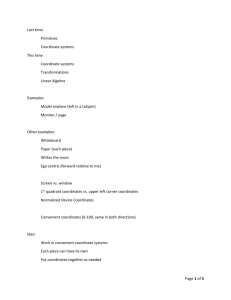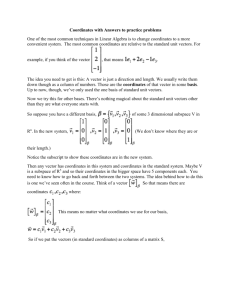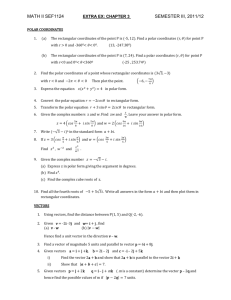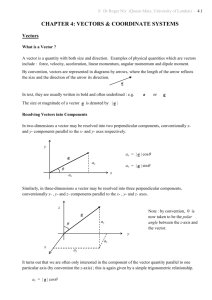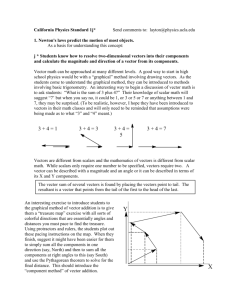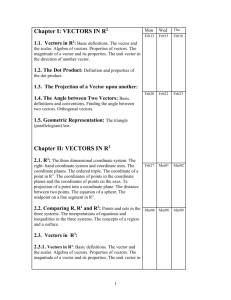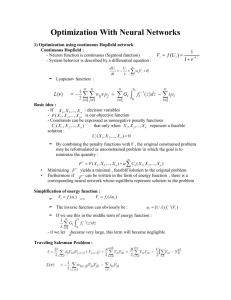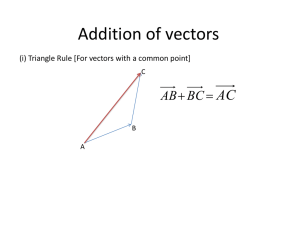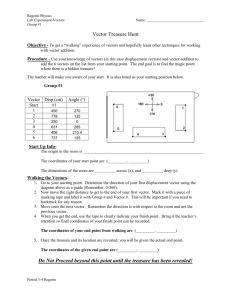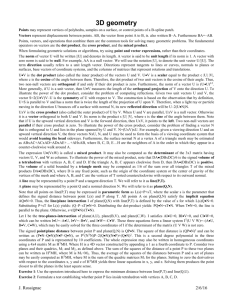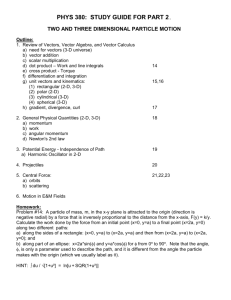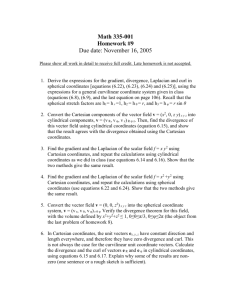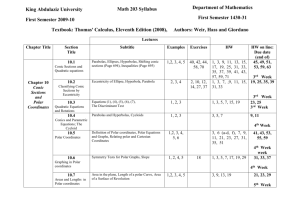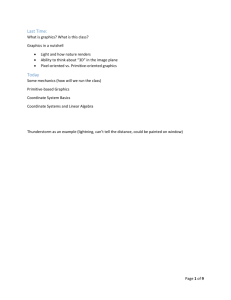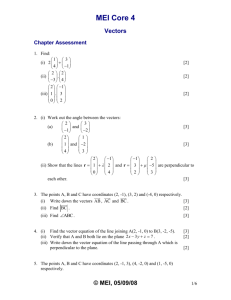Coordinates and Change of basis
advertisement
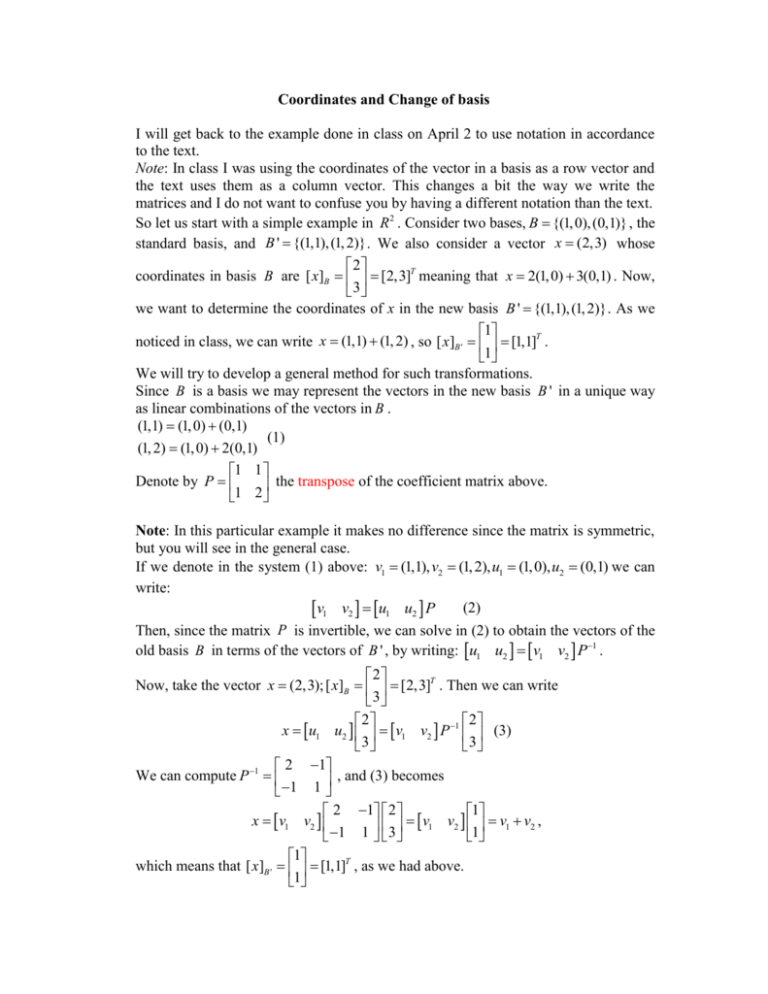
Coordinates and Change of basis
I will get back to the example done in class on April 2 to use notation in accordance
to the text.
Note: In class I was using the coordinates of the vector in a basis as a row vector and
the text uses them as a column vector. This changes a bit the way we write the
matrices and I do not want to confuse you by having a different notation than the text.
So let us start with a simple example in R2 . Consider two bases, B {(1, 0), (0,1)} , the
standard basis, and B ' {(1,1), (1, 2)} . We also consider a vector x (2,3) whose
2
coordinates in basis B are [ x]B [2,3]T meaning that x 2(1, 0) 3(0,1) . Now,
3
we want to determine the coordinates of x in the new basis B ' {(1,1), (1, 2)} . As we
1
noticed in class, we can write x (1,1) (1, 2) , so [ x]B ' [1,1]T .
1
We will try to develop a general method for such transformations.
Since B is a basis we may represent the vectors in the new basis B ' in a unique way
as linear combinations of the vectors in B .
(1,1) (1, 0) (0,1)
(1)
(1, 2) (1, 0) 2(0,1)
1 1
Denote by P
the transpose of the coefficient matrix above.
1 2
Note: In this particular example it makes no difference since the matrix is symmetric,
but you will see in the general case.
If we denote in the system (1) above: v1 (1,1), v2 (1, 2), u1 (1,0), u2 (0,1) we can
write:
v1 v2 u1 u2 P (2)
Then, since the matrix P is invertible, we can solve in (2) to obtain the vectors of the
old basis B in terms of the vectors of B ' , by writing: u1 u2 v1 v2 P1 .
2
Now, take the vector x (2,3); [ x]B [2,3]T . Then we can write
3
2
2
x u1 u2 v1 v2 P 1 (3)
3
3
2 1
We can compute P 1
, and (3) becomes
1 1
2 1 2
1
x v1 v2
v1 v2 v1 v2 ,
1 1 3
1
1
which means that [ x]B ' [1,1]T , as we had above.
1
We now look at the general case, which is considered on page 246 in your text. We
denote as before by B {u1 , u2 ,..., un } the old basis, and B ' {v1 , v2 ,..., vn } the new
basis. We can write
v1 c11u1 c21u2 ... cn1un
v2 c12u1 c22u2 ... cn 2un
(4)
vn c1nu1 c2 nu2 ... cnnun
c11 c12
c
c
Now, if we denote P 21 22
cn1 cn 2
matrix form: v1 v2 ... vn u1
... c1n
... c2 n
, the system (4) above can be written in
...
... cnn
u2 ... un P (5).
Since P must be invertible (because the new set of vectors forms a basis), we can
solve in (5) to obtain the vectors of the old basis B in terms of the vectors of B ' , by
writing: u1 u2 ... un v1 v2 ... vn P1 (6).
Suppose now we have a vector x a1u1 a2u2 ... anun u1 u2
a1
a
... un 2 , so
an
the coordinates of x in basis B are [ x]B a1 a2 ... an .
Using equation (6) in the above expression we get:
a1
a1
a
a
2
1 2
(7).
x u1 u2 ... un
v1 v2 ... vn P
an
an
From (7) it follows that the coordinates of vector x in the basis B ' are given by
a1
a
1 2
[ x ]B ' P
P 1[ x]B . (8)
an
Observation: The matrix P1 in all the above computations is the matrix Q in your
text.
We call the transition matrix from basis B to basis B ' , the matrix Q whose columns
are the coordinates of the basis vectors in B expressed with respect to the basis B ' .
Q [u1 ]B ' [u2 ]B ' ... [un ]B '
T
The inverse of this matrix P , gives the transition from B ' to B , and is given by:
P [v1 ]B [v2 ]B ... [vn ]B
The change of coordinate formula (8) is the expressed as:
[ x]B ' Q[ x]B , or [ x]B P[ x]B '
To find the transition matrix from an old basis B to a new basis B ' do the following:
Step 1. Form the matrix B ' | B in which the vectors of the bases are arranged as
columns.
Step 2. Use elementary row operations to reduce the matrix in Step 1 to its reduced
row echelon form.
Step 3. The resulting matrix will be I | Q , Q being the transition matrix.
Example 1. Let us work Exercise 2 in section 4.7. We have:
B {(1, 4), (4, 1)},[ x]B [2,3]T . We want to find the coordinates of
x in B ' {(1, 0), (0,1)} .
To find the transition matrix we write:
1 0 1 4
B ' | B
I | Q .
0 1 4 1
1 4 2 14
So, [ x]B ' Q[ x]B
.
4 1 3 11
We may check directly that x 2(1, 4) 3(4, 1) (14, 11) 14(1, 0) 11(0,1) .
Exercise 6. This is just like exercise 2 above. Since
basis in R4 , the transition matrix is just
4 0 3 0
4 0 3
0 5 4 1
and we have [ x]B ' 0 5 4
Q
7 1 2 5
7 1 2
3 1 1 0
3 1 1
the new basis is the standard
0 2 20
1 3 32
.
5 4 4
0 1 5
1
1
Exercise 10. The given vector x (3, ,8) 3(1, 0, 0) (0,1, 0) 8(0, 0,1) is with
2
2
3
respect to the standard basis in R . Here the new basis is the basis B. We need to find
[ x]B Q[ x]standard . We proceed to finding Q , the transition matrix from the standard
basis to the basis B. We have, with Maple’s valuable help:
12
17
3 3
2 4 1 1 0 0 1 0 0 8
5
5
4 5 1 0 1 0 0 1 0 12 16 26 , therefore
2 2
5
5
1 0 2 0 0 1
6
6
0 0 1 4
5
5
12
8
5
16
[ x]B 12
5
6
4
5
17
5 3 2
26 1
4 .
5 2
3
6 8
5
Now, if you’ve made it up to here, you may work some problems on your own.
Bring them on Monday to class to get some extra credit!!
I would like to see the work done, not just the answer, please.
Exercises: 4, 9, 11, 12 (I strongly recommend using Maple or similar software), 18,
20.


